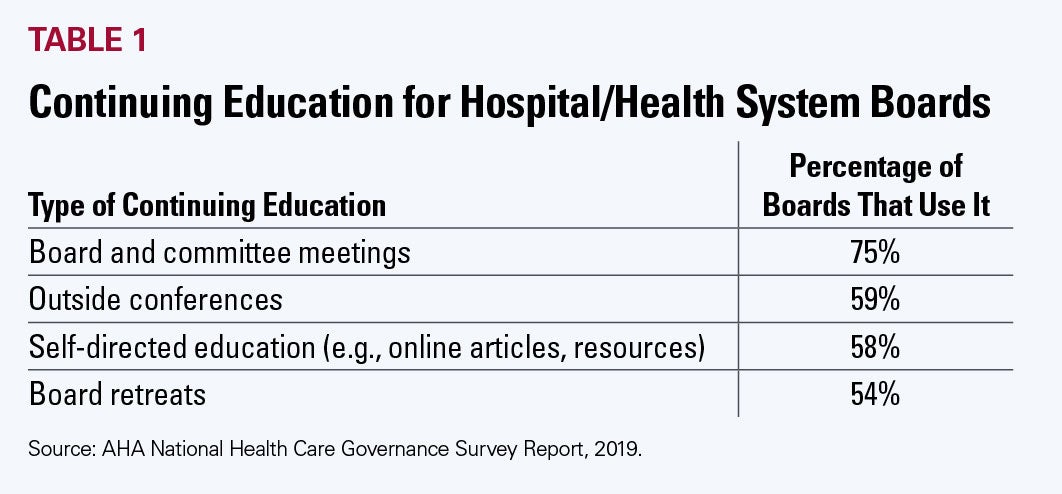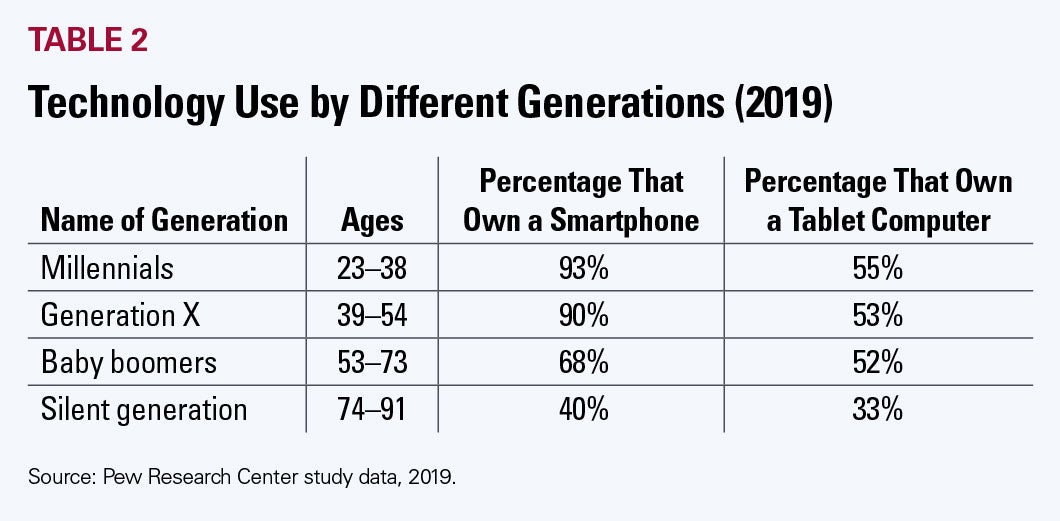
Transforming Governance
Using Technology to Enhance Board Education
Newer approaches will meet the needs of today’s trustees
By Pamela R. Knecht
Health care, like many other fields, is undergoing significant change and disruption. Most hospitals and health systems are simultaneously attempting to maximize revenue from the traditional, volume-based, fee-for-service reimbursement model while moving toward the newer, value-based reimbursement model that emphasizes ensuring high quality and lowering costs along with improving population health. At the same time, new players, like Google and Apple, are entering the health care sector and beginning to disrupt the historical relationships between individuals and their health care providers. For example, Apple watches collect heart rate data that is analyzed by nonlocal entities.
These are examples of external trends that hospital and health system trustees must understand to appropriately fulfill their fiduciary duties to their communities. The best way to stay on top of these types of issues is to have a proactive, comprehensive approach to board continuing education.
Although 82% of boards have formal mandatory orientation programs for new board members, 71% of organizations responding do not have a continuing education requirement for board members. (Data are from the AHA 2019 National Health Care Governance Survey Report.) Given the complexity of the issues facing boards and their organizations, requiring some ongoing education of all trustees should be the standard.
Many high-performing boards require each trustee to have at least 20 hours of continuing education annually. Because they are more knowledgeable about the issues facing the organization, these board members are better able to provide valuable advice to their executive teams during these complex times.
Current Continuing Education Methodologies
According to the AHA 2019 governance survey, hospital and health system boards are participating in continuing education in several ways (see Table 1 below).

Data from The Governance Institute’s 2019 Biennial Survey of Hospitals and Health Care Systems split the “self-directed” category: 74% of respondents received education from publications, and 34% used webinars and online resources.
Changes in Continuing Education Needs
The data shared here underscore a subtle change in the way that board members are choosing to become educated. More board members are taking responsibility for educating themselves through self-directed means such as reading articles, researching topics online, watching webinars, viewing videos and listening to podcasts.
There are multiple reasons that board continuing education is moving in this direction. The newer modalities, like videos and podcasts, meet the needs of today’s board members. Unlike past decades, when trustees were given time off from their jobs to prepare for and attend board and committee meetings, today’s board members often must squeeze their board preparation and participation in between many other commitments. Most are working full-time jobs that require significant time commitments and are actively engaged in their family’s activities. Many also are volunteering in other capacities, in addition to their hospital board service. Board members are busy juggling many commitments, so they want their continuing education—and their board work—to be convenient, portable, just-in-time and personalized.
Technological and Generational Shifts
Personal demands on time have increased while society has been shifting to a more digital world. A 2019 Pew Research Center study found that “millennials stand out for their technology use, but older generations also embrace technology.” The results of this study are relevant to board members of today and tomorrow (see Table 2, below).

Although data in Table 2 show that millennials and Gen Xers rely heavily on smartphones, it also highlights that even baby boomers and the silent generation, to some extent, use smartphones and tablet computers on a regular basis. Therefore, a successful approach to board continuing education must include using these newer technologies to stay relevant, especially to younger board members.
Newer Approaches to Board Education
Some savvy companies and membership associations recognize that to lure and retain knowledgeable board members of all generations, board orientation and education need to be provided using current technology.
- One organization has revised its hospital trustee education platform by moving from offering many 30-minute video courses to offering short videos and podcasts, each of which are 7 to 10 minutes in length. These educational “blasts” can be viewed or listened to on a smartphone.
- A national health care law firm has developed 10- to 15-minute podcasts.
- A trustee education company offers a personalized curriculum of short video and webinar courses based on an initial computerized assessment process.
- Some state hospital associations have contracted with companies to provide educational resources such as webinars, videos, podcasts, articles and interactive courses to their members via their computers and smartphones.
Action Steps
Each of these newer educational approaches is more convenient, portable, just-in-time and personalized than traditional methods. Attending retreats, going to external conferences and receiving education during board and committee meetings are still important, but boards that want to ensure all their members are knowledgeable should consider the following recommendations:
- Add some of the newer modalities and technologies to the educational repertoire.
- Create a board policy that requires each trustee to receive a certain amount of continuing education each year.
- Develop a comprehensive continuing education calendar, outlining all the opportunities available to trustees for the year.
- Provide educational materials in each board packet about issues to be discussed at future meetings.
- With board portals becoming more important, create a section of the portal that includes articles, white papers, podcasts, videos and webinars that will help educate board and committee members (e.g., AHA Trustee Insights).
- Develop a list of topics for board education based on surveys of board members, input from executives, and ideas from governance experts.
- Convene an annual board retreat that includes relevant educational topics, perhaps using an external expert.
- Encourage board members to attend outside conferences and report what they learned to their colleagues (e.g., attending the trustee tracks at AHA conferences).
Education Leads to Engagement
The real reason to ensure that all board members are educated is so they can be full participants, along with key executives, in board and committee discussions. The use of newer technologies is essential to enhancing board education and engaging board members. It is only through active engagement that trustees can ensure their fiduciary duties are fulfilled—and the mission and vision of the organization are achieved.
